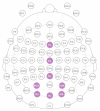Cross-Platform Implementation of an SSVEP-Based BCI for the Control of a 6-DOF Robotic Arm
- PMID: 35808498
- PMCID: PMC9269816
- DOI: 10.3390/s22135000
Cross-Platform Implementation of an SSVEP-Based BCI for the Control of a 6-DOF Robotic Arm
Abstract
Robotics has been successfully applied in the design of collaborative robots for assistance to people with motor disabilities. However, man-machine interaction is difficult for those who suffer severe motor disabilities. The aim of this study was to test the feasibility of a low-cost robotic arm control system with an EEG-based brain-computer interface (BCI). The BCI system relays on the Steady State Visually Evoked Potentials (SSVEP) paradigm. A cross-platform application was obtained in C++. This C++ platform, together with the open-source software Openvibe was used to control a Stäubli robot arm model TX60. Communication between Openvibe and the robot was carried out through the Virtual Reality Peripheral Network (VRPN) protocol. EEG signals were acquired with the 8-channel Enobio amplifier from Neuroelectrics. For the processing of the EEG signals, Common Spatial Pattern (CSP) filters and a Linear Discriminant Analysis classifier (LDA) were used. Five healthy subjects tried the BCI. This work allowed the communication and integration of a well-known BCI development platform such as Openvibe with the specific control software of a robot arm such as Stäubli TX60 using the VRPN protocol. It can be concluded from this study that it is possible to control the robotic arm with an SSVEP-based BCI with a reduced number of dry electrodes to facilitate the use of the system.
Keywords: C++; Electroencephalography (EEG); Steady-State Visually Evoked Potential (SSVEP); brain computer interface (BCI); robot control.
Conflict of interest statement
The authors declare no conflict of interest.
Figures




















Similar articles
-
Control of a 7-DOF Robotic Arm System With an SSVEP-Based BCI.Int J Neural Syst. 2018 Oct;28(8):1850018. doi: 10.1142/S0129065718500181. Epub 2018 Apr 12. Int J Neural Syst. 2018. PMID: 29768990
-
Assistance Device Based on SSVEP-BCI Online to Control a 6-DOF Robotic Arm.Sensors (Basel). 2024 Mar 17;24(6):1922. doi: 10.3390/s24061922. Sensors (Basel). 2024. PMID: 38544185 Free PMC article.
-
Combination of high-frequency SSVEP-based BCI and computer vision for controlling a robotic arm.J Neural Eng. 2019 Apr;16(2):026012. doi: 10.1088/1741-2552/aaf594. Epub 2018 Dec 3. J Neural Eng. 2019. PMID: 30523962
-
A Bibliometric Review of Brain-Computer Interfaces in Motor Imagery and Steady-State Visually Evoked Potentials for Applications in Rehabilitation and Robotics.Sensors (Basel). 2024 Dec 30;25(1):154. doi: 10.3390/s25010154. Sensors (Basel). 2024. PMID: 39796947 Free PMC article. Review.
-
Artificial Intelligence Algorithms in Visual Evoked Potential-Based Brain-Computer Interfaces for Motor Rehabilitation Applications: Systematic Review and Future Directions.Front Hum Neurosci. 2021 Nov 25;15:772837. doi: 10.3389/fnhum.2021.772837. eCollection 2021. Front Hum Neurosci. 2021. PMID: 34899220 Free PMC article. Review.
Cited by
-
Real-Time Mobile Robot Obstacles Detection and Avoidance Through EEG Signals.Brain Sci. 2025 Mar 30;15(4):359. doi: 10.3390/brainsci15040359. Brain Sci. 2025. PMID: 40309849 Free PMC article.
-
Performance investigation of MVMD-MSI algorithm in frequency recognition for SSVEP-based brain-computer interface and its application in robotic arm control.Med Biol Eng Comput. 2025 May;63(5):1367-1381. doi: 10.1007/s11517-024-03236-3. Epub 2024 Dec 27. Med Biol Eng Comput. 2025. PMID: 39725763
-
Effects of Background Music on Mental Fatigue in Steady-State Visually Evoked Potential-Based BCIs.Healthcare (Basel). 2023 Apr 2;11(7):1014. doi: 10.3390/healthcare11071014. Healthcare (Basel). 2023. PMID: 37046941 Free PMC article.
-
EEG-controlled tele-grasping for undefined objects.Front Neurorobot. 2023 Dec 19;17:1293878. doi: 10.3389/fnbot.2023.1293878. eCollection 2023. Front Neurorobot. 2023. PMID: 38186671 Free PMC article.
-
Event-Related Potential-Based Brain-Computer Interface Using the Thai Vowels' and Numerals' Auditory Stimulus Pattern.Sensors (Basel). 2022 Aug 5;22(15):5864. doi: 10.3390/s22155864. Sensors (Basel). 2022. PMID: 35957419 Free PMC article.
References
-
- Lotte F., Nam C.S., Nijholt A. Introduction: Evolution of Brain-Computer Interfaces. In: Nam C.S., Nijholt A., Lotte F., editors. Brain-Computer Interface Handbook: Technological and Theoretical Advances. CRC Press; Oxford, UK: 2018. pp. 1–8.
-
- Wolpaw J.R., Wolpaw E.W. Brain-Computer Interfaces: Something New under the Sun. Brain-Comput. Interfaces Princ. Pract. 2012;3:123–125. doi: 10.1093/acprof:oso/9780195388855.003.0001. - DOI
-
- Klein E., Nam C.S. Neuroethics and Brain-Computer Interfaces (BCIs) Brain-Comput. Interfaces. 2016;3:123–125. doi: 10.1080/2326263X.2016.1210989. - DOI
-
- Nijholt A., Nam C.S. Arts and Brain-Computer Interfaces (BCIs) Brain-Comput. Interfaces. 2015;2:57–59. doi: 10.1080/2326263X.2015.1100514. - DOI
MeSH terms
Grants and funding
LinkOut - more resources
Full Text Sources

